1. Korc-Grodzicki B, Downey RJ, Shahrokni A, Kingham TP, Patel SG, Audisio RA. Surgical considerations in older adults with cancer. J Clin Oncol. 2014; 32:2647–2653. PMID:
25071124.

2. Kim YY, Park MS, Aljoqiman KS, Choi JY, Kim MJ. Gadoxetic acid-enhanced magnetic resonance imaging: hepatocellular carcinoma and mimickers. Clin Mol Hepatol. 2019; 25:223–233. PMID:
30661336.

3. Torimura T, Iwamoto H. Optimizing the management of intermediate-stage hepatocellular carcinoma: current trends and prospects. Clin Mol Hepatol. 2021; 27:236–245. PMID:
33317248.

4. Shin IS, Kim DG, Cha SW, Kang SH, Kim SH, Kim MY, et al. Hepatocellular carcinoma in old age: are there any benefits of liver resection in old age? Ann Surg Treat Res. 2020; 99:65–71. PMID:
32802811.

5. Chon YE, Jeong SW, Jun DW. Hepatocellular carcinoma statistics in South Korea. Clin Mol Hepatol. 2021; 27:512–514. PMID:
34153973.

6. Kinoshita A, Koike K, Nishino H. Clinical features and prognosis of elderly patients with hepatocellular carcinoma not indicated for surgical resection. Geriatr Gerontol Int. 2017; 17:189–201. PMID:
26847184.

7. Frith J, Jones D, Newton JL. Chronic liver disease in an ageing population. Age Ageing. 2009; 38:11–18. PMID:
19029099.

8. Cho E, Cho HA, Jun CH, Kim HJ, Cho SB, Choi SK. A review of hepatocellular carcinoma in elderly patients focused on management and outcomes. In Vivo. 2019; 33:1411–1420. PMID:
31471386.

9. Caglià P, Tracia A, Buffone A, Amodeo L, Tracia L, Amodeo C, et al. Physiopathology and clinical considerations of laparoscopic surgery in the elderly. Int J Surg. 2016; 33 Suppl 1:S97–S102. PMID:
27255126.

10. Kim JM, Kim S, Rhu J, Choi GS, Kwon CH, Joh JW. Elderly hepatocellular carcinoma patients: open or laparoscopic approach? Cancers (Basel). 2020; 12:2281.

11. Kim JM, Kwon CH, Joh JW, Park JB, Ko JS, Lee JH, et al. The effect of alkaline phosphatase and intrahepatic metastases in large hepatocellular carcinoma. World J Surg Oncol. 2013; 11:40. PMID:
23432910.

12. Clavien PA, Barkun J, de Oliveira ML, Vauthey JN, Dindo D, Schulick RD, et al. The Clavien-Dindo classification of surgical complications: five-year experience. Ann Surg. 2009; 250:187–196. PMID:
19638912.
13. Kenkūykai NK. Liver Cancer Study Group of Japan. General rules for the clinical and pathological study of primary liver cancer. 2nd ed. Tokyo: Kanehara & Co.;2003.
14. Edmondson HA, Steiner PE. Primary carcinoma of the liver: a study of 100 cases among 48,900 necropsies. Cancer. 1954; 7:462–503. PMID:
13160935.
15. Wang YY, Zhong JH, Su ZY, Huang JF, Lu SD, Xiang BD, et al. Albumin-bilirubin versus Child-Pugh score as a predictor of outcome after liver resection for hepatocellular carcinoma. Br J Surg. 2016; 103:725–734. PMID:
27005482.

16. Cheng J, Zhao P, Liu J, Liu X, Wu X. Preoperative aspartate aminotransferase-to-platelet ratio index (APRI) is a predictor on postoperative outcomes of hepatocellular carcinoma. Medicine (Baltimore). 2016; 95:e5486. PMID:
27902606.

17. Rhu J, Choi GS, Kwon CH, Kim JM, Joh JW. Learning curve of laparoscopic living donor right hepatectomy. Br J Surg. 2020; 107:278–288. PMID:
31652003.

18. Kim JM, Kwon CH, Yoo H, Kim KS, Lee J, Kim K, et al. Which approach is preferred in left hepatocellular carcinoma?: laparoscopic versus open hepatectomy using propensity score matching. BMC Cancer. 2018; 18:668. PMID:
29921239.

19. Kim JM, Cho BI, Kwon CH, Joh JW, Park JB, Lee JH, et al. Hepatectomy is a reasonable option for older patients with hepatocellular carcinoma. Am J Surg. 2015; 209:391–397. PMID:
25682096.

20. Lee N, Cho CW, Kim JM, Choi GS, Kwon CH, Joh JW. Application of temporary inflow control of the Glissonean pedicle method provides a safe and easy technique for totally laparoscopic hemihepatectomy by Glissonean approach. Ann Surg Treat Res. 2017; 92:383–386. PMID:
28480187.

21. Hori M, Tanaka M, Ando E, Sakata M, Shimose S, Ohno M, et al. Long-term outcome of elderly patients (75 years or older) with hepatocellular carcinoma. Hepatol Res. 2014; 44:975–982. PMID:
24256493.

23. Chen K, Pan Y, Maher H, Zhang B, Zheng XY. Laparoscopic hepatectomy for elderly patients: major findings based on a systematic review and meta-analysis. Medicine (Baltimore). 2018; 97:e11703. PMID:
30045330.
24. Tee MC, Chen L, Peightal D, Franko J, Kim PT, Brahmbhatt RD, et al. Minimally invasive hepatectomy is associated with decreased morbidity and resource utilization in the elderly. Surg Endosc. 2020; 34:5030–5040. PMID:
31820156.

25. Tranchart H, Gaillard M, Chirica M, Ferretti S, Perlemuter G, Naveau S, et al. Multivariate analysis of risk factors for postoperative complications after laparoscopic liver resection. Surg Endosc. 2015; 29:2538–2544. PMID:
25472746.

26. Cho W, Kwon CH, Choi JY, Lee SH, Kim JM, Choi GS, et al. Impact of technical innovation on surgical outcome of laparoscopic major liver resection: 10 years’ experience at a large-volume center. Ann Surg Treat Res. 2019; 96:14–18. PMID:
30603629.

27. Yeh MM, Yeung RS, Apisarnthanarax S, Bhattacharya R, Cuevas C, Harris WP, et al. Multidisciplinary perspective of hepatocellular carcinoma: a Pacific Northwest experience. World J Hepatol. 2015; 7:1460–1483. PMID:
26085907.

28. Lim TS, Kim JK. Is liver biopsy still useful in the era of non-invasive tests? Clin Mol Hepatol. 2020; 26:302–304. PMID:
32646204.

29. Kim JM, Kwon CH, Joh JW, Park JB, Lee JH, Kim SJ, et al. Differences between hepatocellular carcinoma and hepatitis B virus infection in patients with and without cirrhosis. Ann Surg Oncol. 2014; 21:458–465. PMID:
24132624.

30. Kim JM, Kwon CH, Joh JW, Park JB, Lee JH, Kim SJ, et al. Outcomes after curative hepatectomy in patients with non-B non-C hepatocellular carcinoma and hepatitis B virus hepatocellular carcinoma from non-cirrhotic liver. J Surg Oncol. 2014; 110:976–981. PMID:
25171344.

31. Farges O, Malassagne B, Flejou JF, Balzan S, Sauvanet A, Belghiti J. Risk of major liver resection in patients with underlying chronic liver disease: a reappraisal. Ann Surg. 1999; 229:210–215. PMID:
10024102.
32. Wada H, Eguchi H, Nagano H, Kubo S, Nakai T, Kaibori M, et al. Perioperative allogenic blood transfusion is a poor prognostic factor after hepatocellular carcinoma surgery: a multi-center analysis. Surg Today. 2018; 48:73–79. PMID:
28597349.

33. Bennett S, Baker LK, Martel G, Shorr R, Pawlik TM, Tinmouth A, et al. The impact of perioperative red blood cell transfusions in patients undergoing liver resection: a systematic review. HPB (Oxford). 2017; 19:321–330. PMID:
28161216.

34. Hallet J, Mahar AL, Nathens AB, Tsang ME, Beyfuss KA, Lin Y, et al. The impact of perioperative blood transfusions on short-term outcomes following hepatectomy. Hepatobiliary Surg Nutr. 2018; 7:1–10. PMID:
29531938.

35. Zhang Y, Wang R, Yang X. FIB-4 index serves as a noninvasive prognostic biomarker in patients with hepatocellular carcinoma: a meta-analysis. Medicine (Baltimore). 2018; 97:e13696. PMID:
30572498.
36. Xun Y, Tian H, Hu L, Yan P, Yang K, Guo T. The impact of perioperative allogeneic blood transfusion on prognosis of hepatocellular carcinoma after radical hepatectomy: a systematic review and meta-analysis of cohort studies. Medicine (Baltimore). 2018; 97:e12911. PMID:
30412094.
37. Korean Liver Cancer Association. National Cancer Center. 2018 Korean Liver Cancer Association-National Cancer Center Korea practice guidelines for the management of hepatocellular carcinoma. Gut Liver. 2019; 13:227–299. PMID:
31060120.
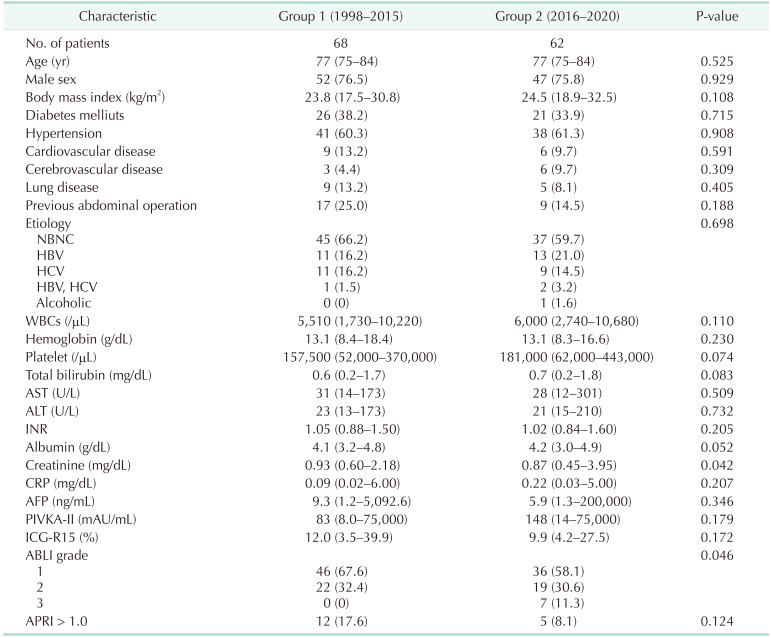
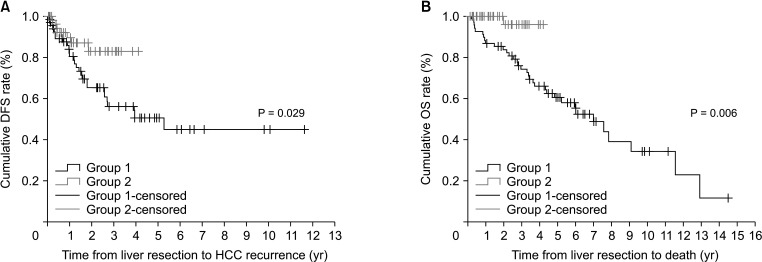
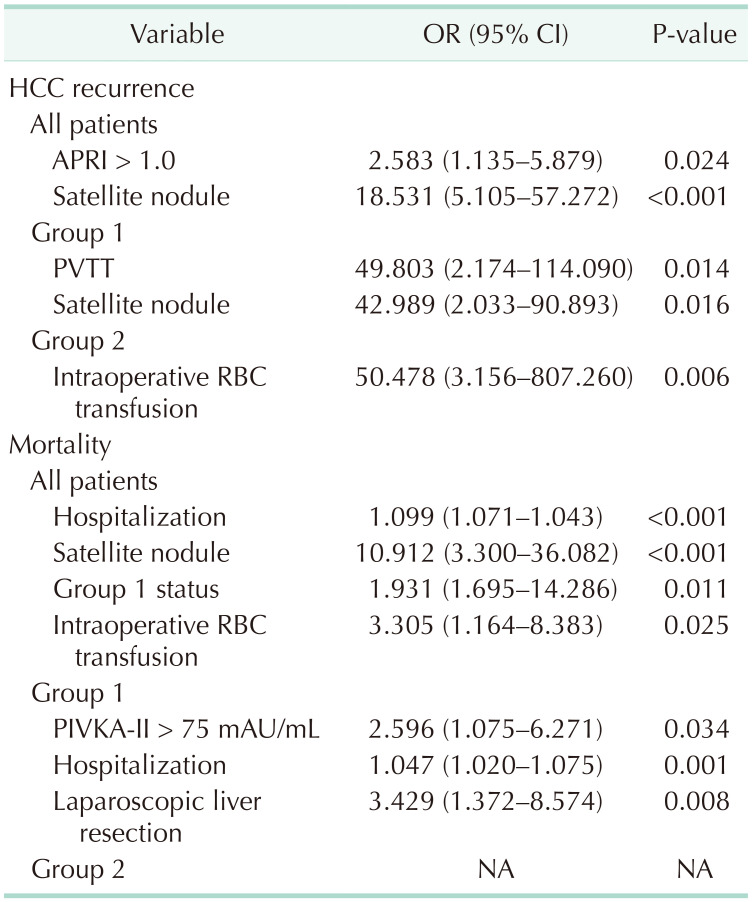




 PDF
PDF Citation
Citation Print
Print



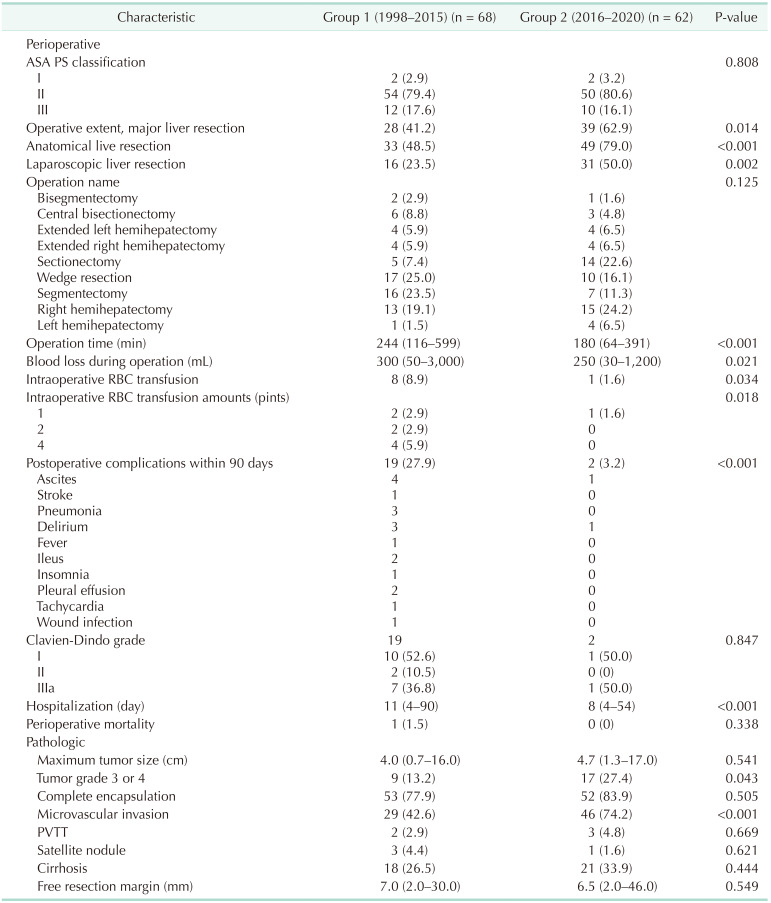
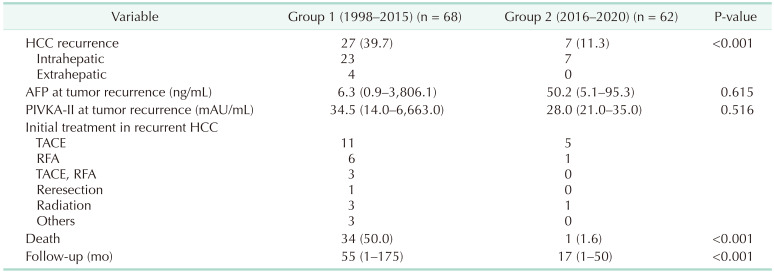
 XML Download
XML Download